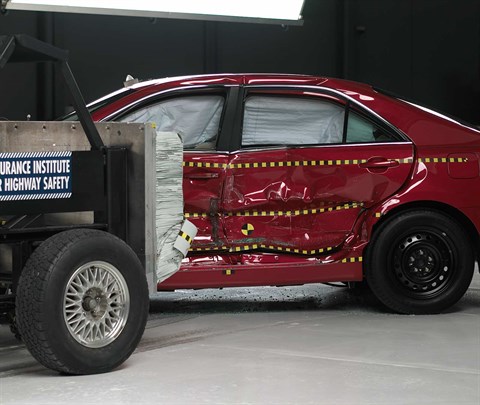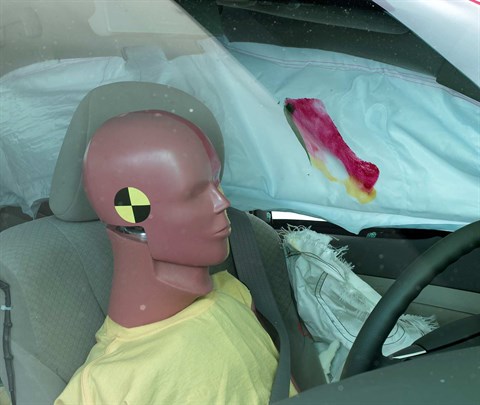Small overlap front: driver-side
Rating applies to 2007-12 models
Tested vehicle: 2012 Lexus ES 350 4-door
The Lexus ES 350 was redesigned for the 2007 model year.
| Evaluation criteria | Rating |
|---|---|
| Structure and safety cage | |
| Driver injury measures | |
| Head/neck | |
| Chest | |
| Hip/thigh | |
| Lower leg/foot | |
| Driver restraints and dummy kinematics The dummy’s head barely contacted the frontal airbag before sliding off the left side and leaving the head vulnerable to contact with forward side structure. The steering column moved upward 18 cm and 14 cm to the right, contributing to a lack of protection for the head and allowing little airbag cushioning for the chest. The side curtain airbag did not deploy, leaving the dummy's head vulnerable to contact with side structure and outside objects. | |

Action shot taken during the small overlap frontal crash test.

The dummy's position in relation to the door frame, steering wheel, and instrument panel after the crash test indicates that the driver's survival space wasn't maintained well.

During the crash, the steering column moved sharply upward and to the right, leaving the dummy's head and chest unprotected from impact with hard interior surfaces and outside objects.

Intrusion into the occupant compartment was extensive. The door hinge pillar was torn off from the door sill as the left front wheel was forced rearward during the crash. This intrusion contributed to a high risk of injuries to the left knee and left lower leg, and a significant risk of injury to the left hip.
Moderate overlap front: original test
Rating applies to 2007-12 models
Tested vehicle: 2007 Toyota Camry LE 4-door
The Toyota Camry was redesigned for the 2007 model year. Frontal ratings are assigned by the Institute based on a test conducted by Toyota. The Camry was redesigned again for the 2012 model year, so these ratings do not apply to 2012 models.
The frontal offset crash test ratings also apply to the Lexus ES 350, the midsize luxury/near luxury version of the Camry, beginning with 2007 models and continuing through the 2012 models, which were not redesigned.
| Evaluation criteria | Rating |
|---|---|
| Overall evaluation | |
| Structure and safety cage | |
| Driver injury measures | |
| Head/neck | |
| Chest | |
| Leg/foot, left | |
| Leg/foot, right | |
| Driver restraints and dummy kinematics | |
Side: original test
Rating applies to 2007-12 models
Tested vehicle: 2007 Toyota Camry LE 4-door with standard front and rear head curtain airbags and standard front seat-mounted torso airbags
The Toyota Camry was redesigned for the 2007 model year. The Camry was redesigned again for the 2012 model year, so these ratings do not apply to 2012 models.
The side impact crash test ratings also apply to the Lexus ES 350, the midsize luxury/near luxury version of the Camry, beginning with 2007 models and continuing through the 2012 models, which were not redesigned.
| Evaluation criteria | Rating |
|---|---|
| Overall evaluation | |
| Structure and safety cage | |
| Driver injury measures | |
| Head/neck | |
| Torso | |
| Pelvis/leg | |
| Driver head protection | |
| Rear passenger injury measures | |
| Head/neck | |
| Torso | |
| Pelvis/leg | |
| Rear passenger head protection | |

View of the vehicle and barrier just after the crash test.

View of the vehicle after the crash with doors removed, showing the side airbags and damage to the occupant compartment.

Smeared greasepaint shows where the driver dummy's head was protected from being hit by hard structures by the side curtain airbag.

Smeared greasepaint shows where the rear passenger dummy’s head was protected by the side airbag.
Roof strength
Rating applies to 2007-12 models
Tested vehicle: 2011 Lexus ES 350 4-door
| Overall evaluation | |
|---|---|
| Curb weight | 3,601 lbs |
| Peak force | 18,649 lbs |
| Strength-to-weight ratio | 5.18 |
Head restraints & seats
Seat type: Power leather seats
| Overall evaluation | |
|---|---|
| Dynamic rating | |
| Seat/head restraint geometry |
About the head restraint & seat test
Currently, IIHS tests apply only to front seats.
